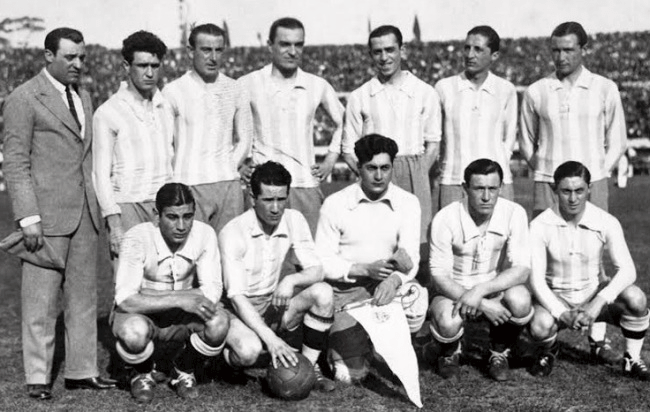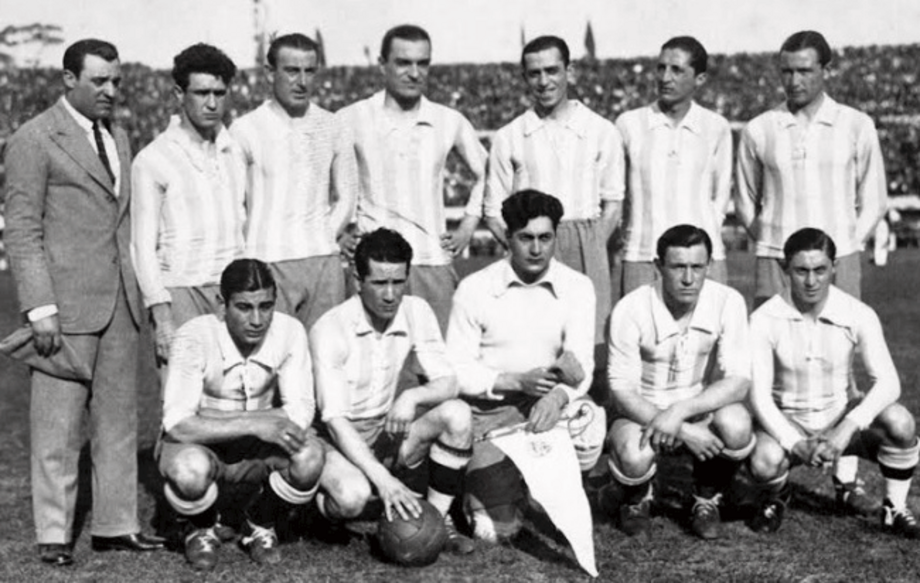1930 WORLD CUP: THE FIRST FOOTBALL WORLD CUP
Learn about the incredible story of the first Football World Cup in 1930.
Conceived by the visionary Frenchman Jules Rimet, the first World Cup in 1930 was the kickoff for field football to become popular and professionalized around the world.
The staging of the first Football World Cup, however, took place with many controversies and rivalries!
HOW THE FIRST CUP CAME ABOUT
It all started when the International Olympic Committee (IOC) announced that field football would not participate in the 1932 Olympic Games because of its low popularity in the United States, the host country for the event.
FIFA disagreed about this exclusion, as it wanted to professionalize the sport.
In 1928, Monsieur Jules Rimet, the French president of FIFA at the time, announced the creation of a tournament that would also be held every four years, but now exclusively for football: the World Cup.
URUGUAY: HOST COUNTRY OF THE FIRST CUP
With five candidate countries, FIFA chose the capital Montevideo, Uruguay, to host the first World Cup.
This choice was not by chance: it was the centennial year of the country’s independence and the Uruguayan national team had won the last two Olympic football titles.
Despite the tribute, this decision caused some problems for the organization of the event.
CONTROVERSIES AND THE BEGINNING OF THE FIRST CUP
The choice of Uruguay, a South American country, caused several countries to drop out of the competition due to the cost and length of the trip.
It is important to remember that football was still seen as an amateur sport and did not receive proper investment.
COUNTRIES PARTICIPATING IN THE FIRST WORLD CUP
This meant that only 13 teams took part in the event, without knockout matches: four from Europe (France, Belgium, Romania, and Yugoslavia), seven from South America (Brazil, Argentina, Bolivia, Uruguay, Paraguay, Chile, and Peru), and two from North America (the United States and Mexico).
The first World Cup took place from July 13 to July 30, 1930, under a harsh winter. It was divided into four groups, where Argentina, the United States, Uruguay, and Yugoslavia qualified for the semifinals.
THE FIRST GOAL IN WORLD CUPS
France’s Lucien Laurent scored, in the 19th minute, the first goal in World Cup history against Mexico at the Pócitos Stadium.
BRAZIL’S TEAM IN THE FIRST WORLD CUP
The team entered a triangular match between Yugoslavia and Bolivia, where only the first of the group would qualify. In the first game, it would lose 2-1 to Yugoslavia and in the second game it would defeat Bolivia 4-0, but would be eliminated still in the first phase of this Cup.
The news of the elimination reached the country by telegram and caused sadness, as well as mockery from the Paulistas (people born in São Paulo) to the Cariocas (people born in Rio de Janeiro).
THE FINAL OF THE FIRST CUP IN 1930

The final of the first cup took place on July 30, 1930, in the legendary Estadio Centenario in Montevideo, which was ready when the World Cup had already begun.
Argentina and Uruguay were repeating the decisive football match in the 1928 Summer Olympics, in which Uruguay won 2-1.
BEFORE THE FINAL GAME OF THE FIRST CUP
Some peculiar events occurred before the final.
The two finalist teams could not agree on who should start the match and what ball would be used, forcing the federation to intervene and decide that the Argentine team would start the match and provide the ball in the first half and the Uruguayans would provide the ball and start the match in the second half.
Luis Monti, played the final for Argentina, despite receiving death threats the day before the match.
The referee was the Belgian, John Langenus, only agreed to referee a few hours before the game, having sought guarantees for his safety.
One of his requests was that a boat be ready in the harbor within an hour of the final whistle, in case he needed to make a quick getaway.
DURING THE FINAL GAME OF THE FIRST CUP
Uruguay scored first through Pablo Dorado, after a low shot on goal.
After eight minutes, Carlos Peucelle, who received a pass from Ferreira, scored and tied the game.
Just before the break, Guillermo Stábile, the tournament’s top scorer, scored and turned the score 2-1 for Argentina.
Uruguay’s captain, José Nasazzi, protested! Claiming that Stábile was offside, but the goal was confirmed by the referee.
In the second half, Uruguay grew in the game. Soon after Argentina almost went ahead, Uruguay counterattacked and José Pedro Cea tied the match again at 2-2.
Ten minutes later, Santos Iriarte, scores and turns the game back in Uruguay’s favor.
And just before the end of the match, Héctor Castro, scored the last goal, closing the score 4-2 to Uruguay.
With an audience of 93,000 people and a score of 4-2, Uruguay became the first World Cup champion and was awarded the famous Jules Rimet Cup.
AFTER THE FIRST CUP FINAL
The next day was declared a national holiday in Uruguay, while in the Argentine capital Buenos Aires, a mob threw stones at the Uruguayan embassy.
Francisco Varallo, who played as a striker for Argentina, was the last player of the final to pass away, on August 30, 2010.
With eight goals, Guillermo Stábile, was the top scorer of the tournament.
FINAL RANKING OF THE FIRST WORLD CUP
Uruguay was the grand champion, with Argentina second, the United States third, Yugoslavia fourth, Chile fifth, and Brazil sixth.
World Cup Series:
- Episode 01: World Cup of 30
- Episode 02: World Cup of 34
- Episode 03: World Cup of 38
- Episode 04: World cup of 50
BIBLIOGRAPHIC REFERENCES
DUARTE, Orlando. Enciclopédia: Todas as Copas do Mundo. São Paulo: Makron Books, 1998.
FIFA. 1950 FIFA World Cup Brazil. Available at: < http://www.fifa.com/worldcup/archive/brazil1950/index.html >. Accessed on: 08/01/2018
